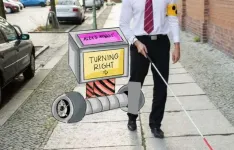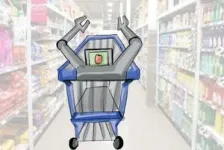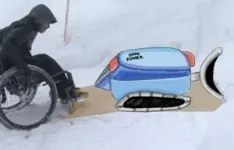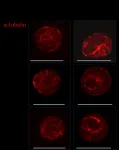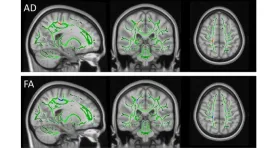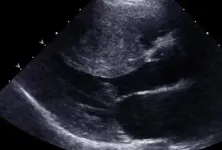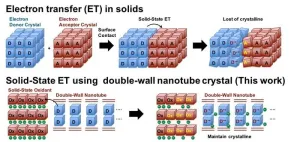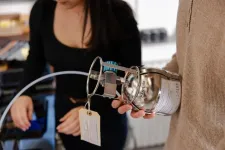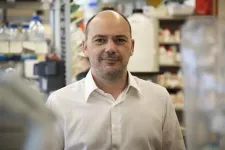(Press-News.org) A new study by Carnegie Mellon University researchers found that when roboticists and people with disabilities collaborate on robot designs, interesting ideas emerge that could make existing robots more accessible and inspire new uses.
In their research, School of Computer Science faculty members Sarah Fox and Nikolas Martelaro highlight potential issues sidewalk robots encounter during deployment and propose solutions to mitigate them before the robots hit the streets. Their new study, led by Human-Computer Interaction Institute (HCII) Ph.D. student Howard Han, was presented last month at the ACM Conference on Human Factors in Computing Systems (CHI 2024).
Sidewalk delivery robots have experienced a recent boom in popularity, especially during the pandemic. But their proliferation comes with conflict, as they typically compete with pedestrians for limited sidewalk space. For people with mobility disabilities, a robot on the sidewalk can eliminate the only safe path, like when a delivery robot at the University of Pittsburgh blocked a wheelchair user from accessing a ramp in 2019.
The new research by Fox and Martelaro, both assistant professors in the HCII, draws on discussions they facilitated between roboticists and people with mobility disabilities to determine the most concerning accessibility problems and how robots can do better.
In the study, they found that one reason accessibility accommodations aren't considered earlier in the design process is that most companies making sidewalk robots are startups, and things move quickly.
"There's not really the time or incentive to slow down in the ways needed to get that type of input from a variety of stakeholders, including people with disabilities," Fox said.
In interviews for the study, roboticists did acknowledge a lack of consideration for users with mobility challenges as a common problem in the field. However, they also expressed a desire for better industry standards and regulations that could help account for the needs of a variety of users, similar to the Web Content Accessibility Guidelines for web accessibility standards. These policies could drive technical design not only for delivery robots but also for other types of public robots.
"One of the things that we're inspired by from this work is the notion of public service robots," Fox said. "What's fun about the most recent paper is that through this collaborative design opportunity of having people with disabilities and roboticists working together, they conceptualized a number of other ideas for robots that operate on the sidewalk and in public that aren't just for delivery."
For example, robots could clear sidewalks of debris or snow, provide directions, act as crossing guards, carry books and other supplies for people, or help humans shop in stores. Sidewalk robots could also report traffic or blocked paths. If the robot detects an issue that could impede access for users in wheelchairs, it could potentially alert them to it through a mobile app, much like Waze or Google Maps does for car traffic.
This work builds on a 2021 study that focused on how sidewalk robots inhibit access to public walkways, and a 2023 observational study Fox and Martelaro conducted in partnership with a company that ran a delivery robot pilot in Pittsburgh.
Across previous studies, Fox and Martelaro have documented the limitations of sidewalk robots.
"Most often, they're operating around campuses," Martelaro said. "Campuses are more controlled. They have walkways that are better managed and maintained. Also, the population is more likely to accommodate the robots."
But when it comes to open world exploration — like the pilot that ran in the Pittsburgh neighborhoods of Garfield, Bloomfield and Lawrenceville — many challenges arise. Robots can't traverse sidewalks that are broken or cluttered with parked cars, trash cans or other unexpected obstacles. Many of these robots would get stuck, fall into planters and require human assistance to get back on their way.
The new study uncovered additional limitations when these robots had to serve customers with disabilities. For example, while sidewalk robots can usually tote food from one location to another, users with mobility disabilities typically need the delivery person to come to their doorstep or even set a pizza on their countertop. Robots can't complete that last stretch because they don't yet know how to climb stairs or take an elevator.
"Accessibility is essentially a known problem," Fox said. "Roboticists understand that consideration for accessibility often comes too late in the design process — often at the very end."
But sometimes, accounting for these considerations could require dramatic redesigns or entirely new features.
"There were a number of interesting ideas where people saw potential use cases that could serve them. But the robot needs to be explicitly designed for that case," Martelaro said. "If you step a little bit beyond a robot that rolls around and has some lights and visuals on it to something that has an arm on it, that becomes a more technically challenging task."
Having different stakeholders involved in the design process also sparked interesting conversations about how the robots should look and the valuable tasks they could accomplish.
"There were some conversations specifically around the grocery-fetching robot," Fox said. "One of the ideas was that it could stand up and reach something on a high shelf. The participant with a disability was pretty firm on this idea being something worth pursuing, and the roboticist said that this could actually scare people because it could be read as creepy or foreboding."
Beyond brainstorming how to design robots, part of Fox and Martelaro's future research also focuses on testing these designs in a cost-effective but expansive manner.
"This idea of engaging people has been a thread through our work. However, we're trying to look into deeper engagement with relevant stakeholders," Martelaro said.
END
Robots could clear snow, assist at crosswalks, monitor sidewalks for traffic
Carnegie Mellon University study explores what happens when roboticists, people with disabilities collaborate
2024-06-04
ELSE PRESS RELEASES FROM THIS DATE:
US drug-related infant deaths more than doubled from 2018 to 2022
2024-06-04
A new study by Florida Atlantic University’s Schmidt College of Medicine has uncovered a disturbing trend in drug-related infant deaths in the United States from 2018 to 2022.
Infant deaths are those that occur between the time a child is born and age 1. Drug-involved deaths are those in which drugs are either the primary cause of death or a contributing factor and may occur due to maternal drug use, inadvertent or accidental intake of specific prescriptions, illicit or non-medical use of drugs and other incidents where drugs were linked to death.
Results of the study, published in the Journal of Perinatal Medicine, show that in the U.S. from 2018 to 2022, drug-involved ...
Duke-NUS breakthrough discovery identifies first step in allergic reactions, paving the way for new preventative strategies
2024-06-04
Scientists at Duke-NUS Medical School have identified how the first domino falls after a person encounters an allergen, such as peanuts, shellfish, pollen or dust mites. Their discovery, published in the April issue of Nature Immunology, could herald the development of drugs to prevent these severe reactions.
It is well established that when mast cells, a type of immune cell, mistake a harmless substance, such as peanuts or dust mites, as a threat, they release an immediate first wave of bioactive chemicals against the perceived threat. When mast cells, which reside under the skin, around blood vessels and in the linings of the airways and the gastrointestinal tract, simultaneously release ...
Researchers explore the neurobiological basis of child abuse by maltreating mothers
2024-06-04
As sad as it is, child maltreatment continues to be a prevalent global social issue. Recent studies have revealed that up to one billion children aged two to 17 experience some form of abuse or neglect every year. While it is possible that some children may eventually overcome these experiences, abundant evidence indicates that child abuse can continue to have a lasting negative impact on brain and mental development, even as these children age. Therefore, prioritizing the prevention of this menacing behavior is crucial.
One way to pursue this goal is to focus on the underlying causes that lead to the perpetuation of abuse, ...
Scientists push single-molecule DNA sequencing to the next level
2024-06-04
SAN FRANCISCO—June 4, 2024—In recent years, technologies that allow scientists to study a person’s DNA at single-molecule resolution have vastly expanded our knowledge of the human genome, the microbiome, and the genetic basis of disease. With such a detailed view of DNA, it’s possible to see genetic variants and structural details that were simply undetectable with earlier sequencing technologies.
However, today’s gold-standard methods for single-molecule analysis typically require at least 150,000 human cells—containing millions of individual DNA molecules. That means researchers can’t apply these tools when just ...
New telehealth stroke certification available to health care professionals
2024-06-04
DALLAS, June 4, 2024 — Significant barriers prevent or slow treatment for many patients with stroke, including long travel times to stroke center hospitals and the lack of availability of stroke specialists who can evaluate the patient and determine if they are a candidate for treatment.[1] Telehealth stroke care, also known as telestroke, can expand access to rural areas and other communities that face barriers to stroke care.
A new American Heart Association certification for health care professionals is designed to help standardize training and increase skills and competencies for health care providers ...
Allen Institute for Cell Science launches first disease-specific cell line collections
2024-06-04
By Jake Siegel
Seattle, WASH.—June 4, 2024—The Allen Institute for Cell Science unveiled a set of tools to accelerate research into hypertrophic cardiomyopathy (HCM), the most common genetic heart condition in the world: six new cell line collections, each carrying a different mutation associated with HCM.
HCM is primarily caused by mutations that thicken heart muscle and, in rare cases, lead to heart failure and cardiac arrest. The new cell line collections will help scientists investigate ...
Towards next-gen functional materials: direct observation of electron transfer in solids
2024-06-04
Electron transfer (ET) is a process in which an electron is transferred from one atom or molecule to another. ET is fundamental to electrochemical reactions with applications in many fields. Nanoscale ET, which involves the transfer of electrons in the range of 1–100 nanometers in solids is fundamental to the design of multifunctional materials. However, this process is not yet clearly understood.
Nanotubes, nanomaterials with unique cylindrical nanostructures, offer a variety of ET properties that can be realized through electron and hole (vacant spaces left by electrons) injections into the nanotubes, making them a suitable candidate for studying nanoscale ET. Although ...
How stress knocks out your cognitive reserve
2024-06-04
While mentally stimulating activities and life experiences can improve cognition in memory clinic patients, stress undermines this beneficial relationship. This is according to a new study from Karolinska Institutet published in Alzheimer’s & Dementia: The Journal of the Alzheimer’s Association.
Researchers in the late 1980s found that some individuals who showed no apparent symptoms of dementia during their lifetime had brain changes consistent with an advanced stage of Alzheimer’s disease. It has since been postulated that so-called ...
New study confirms presence of benzene in natural gas and potential for undetectable indoor leaks
2024-06-04
OAKLAND, CA – New research finds that even people with an average sense of smell could be living with a natural gas leak and not know it. The peer-reviewed study, published in Environmental Research Letters, finds that small gas leaks can impact indoor air quality by introducing a number of hazardous air pollutants, including the carcinogen benzene, which researchers found in 97% of natural gas samples across North America.
“While these smaller leaks are not large enough to cause gas explosions, hard-to-smell leaks are common,” ...
Allergy or infection? Scientists discover what distinguishes these two immune system responses
2024-06-04
The production of antibodies, essential for protecting our body against infections, is very well regulated through the action of a specific subtype of immune system cells, follicular helper lymphocytes. Now, a team led by Luís Graça, group leader at the Instituto de MedicinaMolecular João Lobo Antunes (iMM) and Professor at the Faculty of Medicine of the University of Lisbon, has dedicated itself to the detailed characterization of the functioning of these cells, in an article published today in the prestigious ...
LAST 30 PRESS RELEASES:
A new, cleaner way to make this common fertilizer
Fire-safe all-solid-state batteries move closer to commercialization
Disinfecting drinking water produces potentially toxic byproducts — new AI model is helping to identify them
Unplanned cesarean deliveries linked to higher risk of acute psychological stress after childbirth
Healthy aging 2026: fresh pork in plant-forward diets supported strength and brain-health biomarkers in older adults
Scientists identify pre-cancerous states in seemingly normal aging tissues
Itaconate modifications: mechanisms and applications
Potential tumor-suppressing gene identified in pancreatic cancer
Winners of the 2026 Hill Prizes announced
Autonomous AI agents developed to detect early signs of cognitive decline
Study finds ocean impacts nearly double economic cost of climate change
Increased deciduous tree dominance reduces wildfire carbon losses in boreal forests
Researchers discover how a respiratory bacterium obtains essential lipids from the human body and targets fat-rich tissues
Locust swarms destroy crops. Scientists found a way to stop that
More resources and collaboration needed to support prevention and treatment of obesity
Two types of underconfidence linked to anxiety and gender
Insects are victims too: Global study shows impacts of invasive alien species on populations
Pioneering natural, degradable polymer capsules
Forestry is becoming digital and automated
Maternity baby deaths much higher in northern England than in the South
Mosquitoes’ thirst for human blood has increased as biodiversity loss worsens
The stop-smoking medication varenicline may also work for cannabis use disorder
Potential new treatment for sepsis
Study reveals how many hours of video games per week might be too many
Electrospinning for mimicking bioelectric microenvironment in tissue regeneration
Home fingertip oxygen monitors less accurate for people with darker skin tones
Six weeks in a cast no less effective than surgery for unstable ankle fractures
Precautionary approach to alcohol-free and low alcohol drinks needed to protect public health, say experts
Gas-atomized Ca–Mg alloy powders produce hydrogen simply by adding water — high-efficiency hydrogen generation at room temperature
British redcoat’s lost memoir reveals harsh realities of life as a disabled veteran
[Press-News.org] Robots could clear snow, assist at crosswalks, monitor sidewalks for trafficCarnegie Mellon University study explores what happens when roboticists, people with disabilities collaborate
